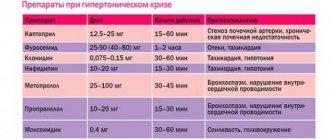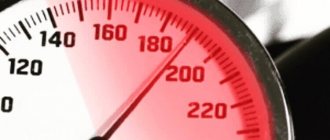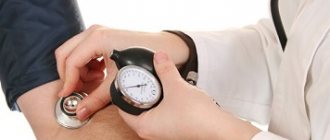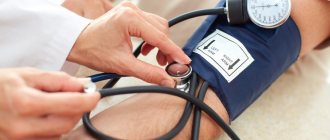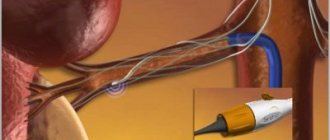Arterial hypotension is a long-term condition in which low blood pressure is observed (less than 100/60 mmHg as a result of decreased vascular tone). Previously, doctors used the term “vegetative-vascular dystonia of the hypotonic type” (VSD of the hypotonic type). There is an opinion that the norms for low blood pressure are different for men and women: for example, the lower limit of systolic (“upper”) blood pressure in men is no more than 100 mmHg, in women – no more than 95 mm. Hg
Causes of arterial hypotension
Causes of low blood pressure may include:
- Dehydration, blood loss, iron deficiency.
- Impaired cardiac function (heart failure, heart defects, pericardial disease, etc.).
- Decreased tone of arterial vessels (poisoning, allergic reactions, etc.).
- Taking large doses of antihypertensive drugs (drugs to lower blood pressure).
- Nervous-psychological stress, neuroses, depression, stress.
- Insufficient physical activity.
- Poor nutrition.
- General fatigue, chronic fatigue.
- Infectious diseases.
- Weather change.
- Hereditary predisposition.
- Lack of body weight.
- Impaired kidney function.
Low blood pressure is not a cause for concern if low blood pressure numbers are observed in a person in most cases and are not accompanied by any health complaints. You should consult a cardiologist if hypotension is not a normal condition for a given person and is combined with a deterioration in general health, greatly reducing the patient’s quality of life.
What low blood pressure is considered life-threatening?
– Life-threatening blood pressure levels may vary for each person and situation.
When blood pressure is below 90/60 mmHg. Art. Most people experience neurological symptoms: dizziness, lightheadedness and fainting. When systolic blood pressure is below 80 mm Hg. Art. the kidneys stop performing their filtration function, shock develops.
But, for example, in hypertensive patients with initially high blood pressure, a sharp and rapid decrease in blood pressure can cause loss of consciousness and even ischemic stroke (with a systolic blood pressure of 100–110 mm Hg). But people of asthenic physique with low body weight (constitutional hypotension) with a blood pressure of 90/60 mm Hg. Art. can feel great.
Forms of arterial hypotension
There are primary and secondary arterial hypotension:
- Primary (essential hypotension) can be caused by a genetic predisposition to low blood pressure (physiological hypotension), or be an independent disease (neurocirculatory asthenia).
- Secondary arterial hypotension can be a consequence of certain diseases (iron deficiency anemia, hepatitis, cirrhosis of the liver, etc.) or develop as a result of taking certain medications (for example, to lower blood pressure), etc.
Treatment
Help before diagnosis
When experiencing low blood pressure, a person needs to lie down with their legs raised up. It is necessary to open the windows to allow fresh air to enter. If you feel faint, rinse your face and neck with cool water. The patient is given strong sweet tea or coffee and a caffeine tablet to drink. For short-term hypotension, these actions are enough to normalize the condition. If your health worsens, urgent medical attention is required.
Drug therapy
The first step in treating low blood pressure is normalizing lifestyle, physical activity and nutrition. If the condition is caused by taking antihypertensive medications, the dose is adjusted or the drug is replaced. When selecting conservative measures, they are based on the main cause of hypotension. The following groups of drugs are used to treat low blood pressure:
- Iron supplements
. Prescribed for iron deficiency anemia in the form of oral or parenteral forms. For low hemoglobin levels due to vitamin deficiency, cyanocobalamin B12 and folic acid preparations are recommended. - Adaptogens
. Medicines based on plant extracts are designed to increase the body's adaptive capabilities. They are effective for physiological causes of low blood pressure and as an addition to etiopathogenetic therapy of other types of hypotension. - Nootropics
. The drugs are prescribed to eliminate cognitive impairment that is caused by chronic insufficiency of cerebral blood supply. To enhance the effect, nootropics are taken in combination with cerebroprotectors and antioxidants. - Adrenergic agonists
. Indicated for emergency care in shock conditions accompanied by a sharp drop in blood pressure. The most commonly administered hormonal drugs are adrenaline and norepinephrine. In critical conditions, analeptics are also used.
Diagnosis and treatment of arterial hypotension at GUTA CLINIC
Diagnosis of arterial hypotension is made by regularly measuring blood pressure. An experienced cardiologist will not ignore the data of a clinical examination, will pay attention to the patient’s complaints, and will most carefully collect anamnesis - all data that may support the diagnosis of arterial hypotension. In the Cardiology Department of GUTA CLINIC, diagnosis of low blood pressure is also carried out using the following examination methods:
- Electrocardiography (ECG).
- Echocardiography (ultrasound of the heart).
- Duplex scanning of cerebral vessels (transcranial method).
- 24-hour blood pressure monitoring.
- Electroencephalography (EEG).
- Ophthalmoscopy.
- Functional diagnostics of the autonomic nervous system, etc.
Treatment of arterial hypotension at GUTA CLINIC is carried out comprehensively, using both classical drug therapy and non-drug treatment methods.
The basis of drug treatment of arterial hypotension is the use of tonic drugs, adaptogens, and general strengthening (including immunomodulating and biostimulating) agents. In addition, the patient is prescribed rehabilitation treatment with normalization of sleep and rest patterns, dosed physical activity, physiotherapy (electrophoresis, electrosleep, water treatments, individual massage course), and dietary adjustments. One should not think that arterial hypotension, low blood pressure, is a less life-threatening condition than arterial hypertension or high blood pressure. If until recently you have not experienced low blood pressure or it was not accompanied by a deterioration in your health, it is better not to delay and immediately consult a cardiologist.
As in the case of arterial hypertension, when a hypertensive crisis may occur, with low blood pressure there is a possibility of developing a hypotensive crisis. Hypotonic crisis is an acute condition characterized by a sharp drop in blood pressure, fainting, convulsions, loss of consciousness, and the development of shock. Often a hypotensive crisis ends in a stroke - an acute cerebrovascular accident that can be fatal.
When there is nowhere lower. Understanding the causes of hypotension
A feeling of “lightheadedness” after a stuffy bus, fatigue after a long night’s sleep, “goosebumps” before the eyes after abruptly getting out of bed... These and other symptoms may indicate a decrease in blood pressure - hypotension. And if numerous studies have been devoted to hypertension and treatment principles have been well developed, then with hypotension not everything is so obvious.
What is it, what causes it, how is it recognized and treated? We are talking about this with our permanent consultant, general practitioner, cardiologist at Clinic Expert Voronezh, Kalinina Angelina Anatolyevna.
— Angelina Anatolyevna, what is hypotension? Is this a diagnosis or a syndrome?
Hypotension is low blood pressure. It can be either just a symptom or a diagnosis.
What does “low blood pressure” mean? This is a condition in which blood pressure numbers are lower than expected for a person in a given situation. And what’s interesting: even if the pressure dropped by 20-30 mmHg. and at the same time remained within the normal range, but the person began to feel worse, then this condition can also be regarded as hypotension.
Read the material on the topic: What should a child’s blood pressure be?
Hypotension can be physiological or pathological. Physiological is a variant of the norm. It may, for example, occur in trained athletes, people living in high mountains or hot climates.
Pathological hypotension. These include essential (or primary) hypotension (hypotonic disease), symptomatic (or secondary) hypotension, as well as idiopathic orthostatic hypotension.
Below normal is:
blood pressure below 100/60 mm Hg. Art. in men and 95/60 mm Hg. Art. among women
according to other data - pressure below 100/60 mmHg. in people under 25 years of age, and below 105/65 mmHg. - over 30 years old
The most common pathological condition is essential hypotension. It is expressed by a steady decrease in blood pressure with characteristic manifestations.
Secondary hypotension is a consequence of another disease or drug use.
— What is low blood pressure? At what numbers can we say that the pressure is below normal?
According to some data, blood pressure is below 100/60 mm Hg. Art. in men and 95/60 mm Hg. Art. among women; according to others - pressure below 100/60 mmHg. in people under 25 years of age, and below 105/65 mmHg. - over 30 years old. Moreover, hypotension is said to occur when both indicators (“upper” and “lower” pressure) or one of them decrease.
— High blood pressure threatens a heart attack or stroke. Why is low blood pressure dangerous?
There is an opinion that with an excessive decrease in blood pressure there is also a risk of developing cardiovascular complications, although studies with the required level of evidence have not been conducted.
With age, hypotension may disappear, giving way to arterial hypertension.
In most cases, the prognosis is favorable. If there are no complaints related to low blood pressure, and the person is adapted to it, then hypotension does not cause much harm to the body.
Read the material on the topic: Spinning until you drop! Why do you get dizzy?
The concern is the progression of the disease, repeated episodes of fainting (and possible falls associated with them), the presence of other concomitant pathologies (coronary heart disease, diabetes mellitus, etc.), as well as the patient’s advanced age (risk of falls, deterioration of blood supply to the brain).
— At what blood pressure levels should you urgently call a doctor? Where is the lowest limit?
Everything here is individual. Those. pressure that is low for one may be normal for another (especially if we are talking about hypotension). Therefore, it is quite difficult to voice the limit of the lowest norm.
However, if the patient has symptoms indicating the development of a threatening condition (pain in the heart or chest, shortness of breath, arrhythmic pulse, vomiting, convulsions, impaired consciousness), this is a reason to call an ambulance with possible hospitalization.
— What does a person experience with low blood pressure? What are the symptoms of hypotension?
The most common manifestations of hypotension are general weakness, fatigue, headaches, a tendency to dizziness, pre- and fainting states. There may also be irritability and deterioration in performance (which, with essential hypotension, is often noted already in the morning). Poor tolerance to transport, stuffiness, heat, movement on an escalator, staying at heights. Nausea, impaired thermoregulation (“chilliness”), sweating, fluctuations in blood pressure - from low to high). Difficulty absorbing information, sleep disorders, noise in the head.
Meteorological conditions, etc. may be reported.
Read material on the topic: What is weather dependence: diagnosis or fiction?
Symptoms of hypotension are more common in young, thin women. They often experience anxiety and low mood.
When collecting anamnesis, hereditary burden may be revealed, i.e. existing or existing cases of low blood pressure in the family.
— What leads to the development of hypotension? For what reasons does this condition develop?
The mechanisms of development of essential hypotension are not fully understood. There are suggestions that it is based on a violation of the so-called neuro-humoral regulation of blood circulation. Hereditary burden is often traced, usually through the female line.
There are many causes of secondary hypotension. It can occur when:
- some endocrine pathologies (reduced function of the thyroid gland - hypothyroidism, adrenal cortex - Addison's disease, autonomic diabetic neuropathy, weakened function of the anterior pituitary gland);
— diseases of the cardiovascular system (heart rhythm disturbances; mitral valve prolapse; pericarditis; heart defects; heart failure; coronary heart disease);
Read material on the topic: Coronary heart disease: diagnosis and treatment
— infections and intoxications;
- shock of various nature;
— neurological pathologies (traumatic brain injury and its consequences; brain tumors; syringomyelia, etc.);
- prolonged bed rest;
- pregnancy;
- lack of fluid;
- allergic reactions;
- taking various medications (psychotropic - antidepressants, anti-anxiety drugs, for the treatment of insomnia; antiarrhythmic; antihypertensive - reducing high blood pressure; diuretics; for the treatment of ischemia; anesthetics).
— Can hypotension turn into hypertension? Under what conditions can this happen?
Yes. With age, hypotension may disappear, giving way to arterial hypertension. Usually the pressure does not increase too much, but is nevertheless poorly tolerated. Moreover, it is even possible when the pressure numbers are still within the normal range (for example, the upper 130-135 mmHg) and cannot even be formally formulated as hypertension.
Read the material on the topic: It's off scale! Looking for reasons for high blood pressure
However, in a “past” hypotensive patient, they can already cause manifestations of classic arterial hypertension: a feeling of “pulsation” in the head, dizziness, redness of the face, nausea, rapid heartbeat. And this condition may require appropriate treatment (of course, with a very careful individual selection of drugs and dosages).
— What diagnostics do you need to undergo for hypotension in order to identify the cause of low blood pressure?
When diagnosing arterial hypotension, a general analysis of blood and urine is performed, some biochemical parameters are examined (including glucose), blood electrolytes, cortisol, thyroid hormones, ultrasound of the heart and thyroid gland, ECG, and 24-hour blood pressure monitoring are performed.
Read material on the topic: Ultrasound of the heart: when is it prescribed and what will it show?
Other ultrasound, as well as X-ray examinations, fibrogastroduodenoscopy - according to indications.
— It is known that doctors recommend keeping a diary for hypertensive patients. Is it necessary to keep the same diary for hypotensive patients?
Yes, it makes sense.
— Is hypotension treated with medication?
Yes, such treatment exists, but there are not many drugs. Some of them have shown themselves to work well in cases of orthostatic hypotension and essential hypotension with a “smooth”, monotonous course.
In practice, they are used relatively rarely and very carefully.
— What folk methods can help a hypotensive person raise their blood pressure? Do coffee, ginseng or eleutherococcus help with hypotension?
There are a number of studies showing a moderate positive effect on hypotensives of tea, coffee, as well as medications containing caffeine.
More of our articles in the company’s official VKontakte group
Ginseng or Eleutherococcus will also be effective to some extent, but their effect has not been fully studied - there is also no evidence base for them, as well as for the drugs mentioned above.
— Angelina Anatolyevna, what rules and recommendations should a hypotensive patient follow in order to improve the quality of their life and not feel overwhelmed and tired?
It is necessary to try to identify factors that cause a decrease in pressure and try to avoid/exclude them. Among them is sudden standing up (to prevent a decrease in pressure for this reason, you must first sit down, bend over, then raise your body and head, and stand up); long stay in an upright position; being in stuffy rooms, high air temperature; physical work, especially in hot conditions, as well as the possible loss of fluid associated with this (therefore it is necessary to control fluid loss).
You need to get enough rest, sleep, and follow a work schedule.
The diet (or, rather, the principles of nutrition) for hypotension consists of frequent meals in small portions, limiting the intake of hot food and drinks; foods rich in easily digestible carbohydrates. You can increase your salt and liquid intake (up to 2–2.5 liters of liquid, 8–10 g of salt per day).
Read material on the topic: Life without meat: food, philosophy or benefits for the body?
People with hypotension should avoid alcoholic beverages. Carefully monitor the intake of any medications, and be sure to warn your doctor about your tendency to low blood pressure.
It is imperative to look for and treat pathologies in which hypotension is secondary, i.e. is one of the manifestations of the underlying disease.
There are special gymnastics aimed at training vascular tone. Its principle is that a person who is in a horizontal position is transferred to a vertical position for a short time. The pressure decreases at this time. Such cycles are repeated, and the vessels gradually “get used” to maintaining the pressure at the proper level, which is especially important if you are prone to fainting. Such gymnastics should only be performed under the supervision of a qualified specialist.
You may also be interested in:
Why is electroencephalography needed? Complete patient guide
What is hidden behind the diagnosis of dyscirculatory encephalopathy?
Vegetative-vascular dystonia: go there - I don’t know where, cure that - I don’t know what
For reference:
Kalinina Angelina Anatolevna
In 2007 she graduated from the Voronezh State Medical Academy named after. Burdenko.
From 2007 to 2008 she completed an internship in therapy, in 2010 she underwent professional retraining in the specialty “General Medical Practice (Family Medicine)”, and in 2017 – in the specialty “Cardiology”.
Since 2015, he has held the position of general practitioner at Clinic Expert Voronezh. Reception is conducted at the address: st. Pushkinskaya, 11.
Hypotension of training
Another form of hypotension that occurs in athletes and simply trained people is training hypotension. But reduced vascular tone does not play a role here, it’s just that the body of such people is constantly under increased stress and therefore is accustomed to working in an “economical” mode.
The main complaints with hypotension are decreased performance, irritability, bad mood, memory may deteriorate, the person becomes distracted, and finds it difficult to concentrate. Emotional instability, increased sensitivity to bright light or loud speech predominates. Headaches and dizziness are common manifestations.
Headache is often associated with fluctuations in atmospheric pressure, large meals, and prolonged standing. The pain is usually localized in the occipital region or frontal region, feels like heaviness, and as the pain increases, the patient feels as if there is “pressure from the inside” on the skull. Sometimes you may experience a feeling of heaviness in the stomach, bitterness in the mouth, loss of appetite, nausea, belching, heartburn, flatulence, constipation - that is, almost all gastrointestinal disorders. In addition, hypotensive men may have reduced sexual potency, and women often experience menstrual irregularities. However, menstruation is often painful.
Hypotonic people often feel tired even after just waking up. They have difficulty waking up in the morning, even after a long sleep, feeling sleepy. Activity and performance return to normal only after 2-3 hours, weakening again during the day. The peak activity of hypotensive patients usually occurs in the late afternoon. With increased physical activity, people with hypotension may experience an increase in pulse and heart rate, and sometimes there are unpleasant sensations in the heart area and shortness of breath, which sometimes make a person suspect that they have angina pectoris or other serious illnesses.
Many hypotensive people constantly yawn, but not because they are tired, but because they “don’t have enough air,” which sometimes causes fainting or darkening of vision when suddenly moving from a horizontal to a vertical position. Sensitivity to weather changes is also a hallmark of people with low blood pressure. Most often, they do not tolerate heat very well, and even worse is the autumn or spring off-season with cloudy weather and low atmospheric pressure. Such people feel best on sunny and frosty winter days with high atmospheric pressure or on warm sunny days in late spring or early autumn. In addition, hypotensive patients are sensitive to weather changes and changes in climatic conditions.
Recommendations and prevention
Doctors recommend following simple rules so that low blood pressure does not worsen life or affect its quality.
Preventive recommendations include following these rules:
- Regularly measure blood pressure, monitor its fluctuations, and apply treatment measures in a timely manner.
- Visit your cardiologist regularly.
- Lead a healthy and active lifestyle.
- Take vitamin complexes and healthy foods.
- Maintain an 8-hour sleep pattern, work and rest, day and night.
- Minimize or completely avoid stress.
- Introduce daily physical activity into your daily routine, do hardening, and think positively.
Why is arterial hypotension dangerous?
Arterial hypotension not only negatively affects the patient’s well-being and deprives him of the opportunity to lead a normal lifestyle and work, but also leads to more serious problems. Due to low pressure, less blood flows to the muscles and heart. Insufficient blood circulation and oxygen starvation of brain tissue develops.
If the pressure drops to a critical level, there is a high risk of cardiogenic shock. Then the patient’s pulse weakens, he loses consciousness, and may even begin to choke. It is important to know that cerebral stroke is also often a consequence of arterial hypertension, as well as hypotension.
If a person suffers from hypotension for a long time, structural changes occur in the blood vessels. As a result, hypertension is diagnosed. Former hypotensive patients tolerate pressure surges much more difficultly than ordinary hypertensive patients. This is why symptoms of low blood pressure cannot be ignored. At the first signs, you should contact a cardiologist.
During pregnancy, hypotension can lead to oxygen starvation of the fetus, which is why it begins to lag behind in development.
Symptoms of hypotension
The symptoms that occur are usually caused by a lack of blood supply to the brain and heart. Here are typical manifestations1:
- headache;
- dizziness, imbalance;
- nausea;
- severe weakness;
- memory impairment;
- decreased performance;
- intolerance to bright light, harsh sounds, stuffiness.
Deterioration in health is accompanied by pain in the heart, rapid or slow heartbeat, and rhythm disturbances.
As soon as such a person gets out of bed in the morning and starts walking, he feels worse due to an even greater decrease in blood pressure, so he wants to go back to bed. Additional symptoms:
- coldness and impaired sensitivity of the extremities (fingers);
- symptoms worsen due to fatigue, stress, lack of sleep, acute infections and exacerbation of any chronic diseases.
How to raise blood pressure
Oddly enough, drinking coffee and tea in the morning is not recommended, but it is better to avoid it altogether. The desire to get a “charge of vigor” in the morning first becomes a habit, and then turns into doping and requires a constant increase in the dose1.
Moderate loads with a smooth increase in duration have a positive effect. For example, walking, exercise bike, gentle jogging, skiing, swimming.
Static loads with a forced posture (working at a computer), tilting the head, lifting heavy objects are best avoided. If it is impossible to alternate them with physical activity.
In the morning, you need to learn to get up slowly so as not to cause a drop in blood pressure. Compression stockings on your legs may also help. It will reduce the amount of blood in the veins of the lower extremities. For training, you can sleep with the head of the bed elevated.
It is better to avoid static loads with a forced posture
Diet for arterial hypotension
During the treatment of arterial hypotension, it is important to follow simple nutritional rules:
- The patient's daily diet should contain sufficient amounts of B vitamins, vitamin C and proteins. Vitamin B3 is especially important (egg yolk, carrots, yeast, liver, milk, green parts of plants, etc.).
- Eat 5-6 times a day in small portions.
- The amount of salt is not limited. If there are no diseases of the gastrointestinal tract, you can eat spicy foods.
- There are beans, nuts, meat, cereal grains, vegetables (especially potatoes).
- Drink coffee, tea, clean water without gas.
If you have hypotension, you should not go hungry or lack sleep. If you feel worse, you can eat candy and drink a glass of sweet tea.
Description of the disease
Hypotension may be hereditary or hereditary due to predisposition. This is the primary physiological type of the disease. Secondary hypotension can be caused by a number of other diseases of the patient - hepatitis, ulcerative conditions of the gastrointestinal tract, cirrhosis of the liver, or develop as a result of side effects of certain medications or taking medicinal herbs.
The disease is diagnosed most often in women 30-40 years old, in whom mental work predominates, as well as in athletes who play sports professionally. A decrease in pressure may occur during climate change, which is temporary.
And although arterial hypotension against the background of other cardiovascular diseases does not pose a serious danger to human life, it significantly reduces the quality of life, causes a lot of inconvenience and prevents the patient from leading a normal life. Hypotension should be treated in the same way as other diseases of the cardiovascular system, without ignoring the symptoms and without waiting for complications.
